
Handicrafts in India are a big tapestry of traditions. India, a place of many cultures and customs, is well-known for its magnificent handicrafts, which represent the country’s creative past. Handicrafts in India are more than just items; they represent a reflection of the country’s history, culture, and skills passed down over generations. This article explores the history, symbolism, regional differences, genres, and forms of Indian handicrafts, emphasizing its importance in the country’s socioeconomic fabric.
Historical Overview
The history of Indian handicrafts dates back to ancient times, with evidence of craftsmanship found in archaeological sites like Mohenjo-Daro and Harappa, which date back to 2500 BCE. The Indus Valley Civilization was known for its bead-making, pottery, and textile production.
Over the centuries, various dynasties and empires, including the Mauryas, Guptas, Mughals, and British, influenced the evolution of handicrafts in India.
During the Mughal era (16th to 18th centuries), there was a significant flourishing of arts and crafts. The Mughals brought Persian influences, leading to the development of intricate designs and techniques in textiles, metalwork, and ceramics.
The British colonial period saw the introduction of new materials and methods, but it also led to the decline of traditional crafts due to industrialization.
Following independence, there has been a renewed interest for handicrafts, with initiatives to encourage and maintain indigenous skills. Government efforts, non-governmental organizations (NGOs), and artisan cooperatives have all played an important part in revitalizing interest in handicrafts, ensuring that these age-old traditions continue to survive.
Symbolism in Handicraft
Handicrafts in India are infused with symbolism, frequently reflecting the beliefs, values, and traditions of the people who make them. Each craft has a unique story, which is sometimes linked to religious or cultural importance. For example:
Textiles
Many Indian textiles include themes representing fertility, prosperity, and spirituality. The choice of colors also conveys significance; for example, red is frequently connected with auspiciousness and marriage, whereas white represents purity.
Pottery
In many locations, pottery is decorated with motifs depicting local flora and animals, as well as geometric patterns of cultural importance. Pottery-making is frequently a ceremonial process, with particular skills passed down through generations.
Woodwork
Intricate carvings in wood frequently reflect mythical stories or local traditions, acting as a storytelling medium that links the artist to their cultural history.

Handicrafts in India:Regional Variations
India’s wide geographical and cultural variety have resulted in a plethora of handcraft styles, each distinct to its location. Here are some noteworthy examples:
Punjab and Haryana: Phulkari
Phulkari, or “flower work,” is a traditional embroidery style from Punjab. It has vivid flower motifs embroidered on shawls, dupattas, and other items. Phulkari is more than a craft; it is a sign of celebration that is commonly worn during weddings and festivals.
Rajasthan: Block Printing and Blue Pottery
Rajasthan is well-known for its block printing skills, especially in places like Jaipur and Sanganer. Craftspeople use hand-carved wooden blocks to print elaborate designs on cloth. Blue pottery, distinguished by its brilliant blue and white motifs, is another example of Rajasthani workmanship.
Gujarat: Bandhani, Patola
Bandhani, often known as tie-dye, is a traditional Gujarati craft in which artists tie and dye fabrics to create beautiful designs. Patola sarees, noted for its double ikat weaving method, are another magnificent skill from the region that is frequently passed down through generations.
West Bengal: Kantha and Shantiniketan
Kantha needlework, which originated in West Bengal, entails sewing together layers of discarded sarees to produce stunning blankets and wall hangings. Rabindranath Tagore’s Shantiniketan School of Art has also played a vital role in promoting traditional crafts.
Karnataka: Mysore Silk and Channapatna Toys
Mysore silk sarees are known for their rich feel and elaborate patterns. Channapatna, a town in Karnataka, is famed for its wooden toys crafted with a traditional lacware method, which include brilliant colors and amusing patterns.
Uttar Pradesh: Benaras silk and Zardozi
Benaras (Varanasi) is famed for its silk weaving, which produces some of India’s best silk saris. Zardozi, a type of needlework with gold and silver threads, is very popular in this region and is commonly used in wedding and ceremonial gowns.
Handicrafts in India: genres
Indian handicrafts may be classified into several categories based on the materials and techniques utilized. Some popular genres include:
Textiles
Textiles are possibly the most famous category of Indian handicrafts. From handloom weaving to embroidery, India has a diverse range of textile traditions. Notable forms are:
Weaving techniques such as ikat, khadi, and brocade are essential to Indian textiles.
Embroidery: Styles like Chikan (Lucknow), Kutch (Gujarat), and Kashida (Kashmir) demonstrate regional variances in embroidery methods.
Pottery and ceramics
Indian pottery spans from clay to exquisite china. Each region has a unique style, such as:
Terracotta: Found in rural regions and used to make pots, figurines, and ornamental objects.
Stoneware: Found in locations such as Khurja (Uttar Pradesh), which is famous for its glazed pottery.
Metalwork
Metal crafts from India include:
Brass and copper are used to create utensils, ornamental goods, and sacred artifacts.
Silver Filigree: A delicate type of metalwork found in Odisha and Andhra Pradesh.
Woodwork
Wooden handicrafts are popular in places like Kerala and Rajasthan, where artists carve elaborate designs for furniture, toys, and ornamental objects.
Jewelry
Indian jewelry is recognized for its variety, with styles changing by location. The traditional forms include:
Kundan: A type of gem setting prevalent in Rajasthan.
Meenakari: Enamel work that provides bright hues to gold and silver jewelry.

Styles of Handicraft in India
The styles of Indian handicrafts are as diverse as the locations from which they originate. A few noteworthy styles are:
Traditional Styles
These styles are firmly established in cultural practices and frequently mirror local conventions and traditions. Kanchipuram silk sarees, for example, have elaborate motifs that have been passed down through generations and are commonly worn during religious events.
Contemporary styles
With the rise of modern design sensibilities, many craftspeople are fusing ancient processes with new aesthetics. This mix has resulted in new goods that appeal to a global audience while preserving their cultural identity.

Handicrafts in India: A Celebration of Eco-Friendly Artistry
Eco-friendly handicrafts in India frequently use natural materials including bamboo, jute, clay, and repurposed products. Artisans are increasingly implementing sustainable techniques to ensure that their creations do not affect the environment. For example, the use of organic dyes in textiles and the resurrection of old waste-reducing practices are becoming increasingly popular. This approach not only helps to preserve the environment, but it also benefits local economies by encouraging traditional handicrafts.
One famous example is the use of terracotta in pottery, which is both biodegradable and visually appealing. Similarly, jute items have grown in popularity due to its long-lasting nature and environmental friendly design. The rebirth of these materials demonstrates the craftsmen’ dedication to sustainability while preserving their cultural legacy.
Furthermore, the government and numerous non-governmental organizations (NGOs) aggressively promote eco-friendly handicrafts through exhibits and fairs, urging customers to pick sustainable alternatives. This not only helps artists receive attention, but it also educates the public on the value of supporting environmentally responsible techniques.
India is known for its rich tapestry of handicrafts, which represent the country’s unique culture, customs, and creative legacy. Indian handicrafts, which range from exquisite fabrics to wonderfully created pottery, are more than simply things; they are stories woven into society’s fabric. In recent years, there has been a substantial trend toward eco-friendly designs in handicrafts, with an emphasis on sustainability and environmental awareness.
The handicrafts of India are more than just things; they represent the country’s identity and ideals. As artists continue to develop and adapt to environmentally friendly procedures, they not only protect their craft but also contribute significantly to a more sustainable future. Embracing these wonderful sculptures allows us to appreciate Indian creativity while also protecting the environment.


